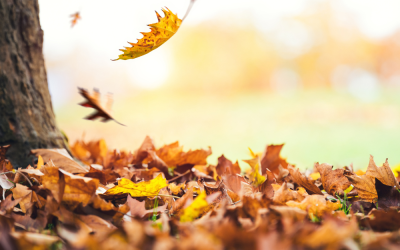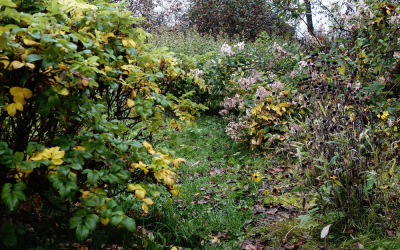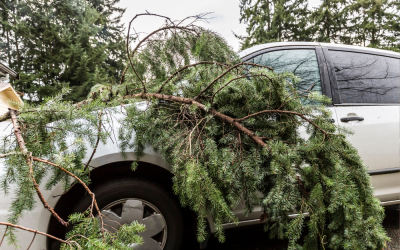Like most gardening tasks, planting a tree requires know-how and timing. Learning about the right tools and techniques for the job can help to give it the best start in life. To help you get started, here is a guide on how to plant a tree, including maintenance tips so that your tree can flourish.
1. When To Plant A Tree
Traditionally, the tree-planting season normally begins in October running through to April – although advancements in arboricultural technology now mean you can plant trees throughout the year, as long as proper post-planting maintenance is provided as needed.
That said, there are some seasonal factors which can affect the development of your tree. Sunny or windy days can quickly damage bare roots – so it’s essential to keep these protected with either a proprietary planting bag or a black bin liner.
Autumnal soil tends to be more moist while retaining some of the warmth from the season before, which can encourage trees to put down new roots. This can then help prepare the tree for healthier, faster growth in the springtime.
2. Choosing Your Tree
When purchasing a shrub or young tree, it will either be balled-and-burlapped (B&B) or potted (although the Woodland Trust recommends avoiding these as they can quickly outgrow their containers and become stressed if moved).
Choose healthy stock from a reputable nursery – and don’t rely on how the trunk and branches look; instead check the root system to see that it’s fresh and that the roots are nor circling or pot-bound.
Young trees ready to be planted are called whips. These are young trees up to 2.5 metres tall with a fibrous, bare root-system and no lateral branches. Whips are the cheapest, easiest and quickest trees to plant, and are best suited to T-notch planting. For a guide on how to do this, see “How to Plant A Tree” (below).
3. The Right Tools For The Job
The right equipment can help ease the planting process. Here’s what you need:
- Your tree
- Spade and fork
- (Optional) a circular cutting tool
- A garden or bin bag
- Stake and tie
- Tree guard or spiral
- Bucket
- Watering can
- Mulch (organic matter like chipped bark)
4. Location
To find the best spot for your tree, you’ll need to consider the following:
- Where it will grow relative to your house, neighbours, and other buildings in addition to footpaths. Also consider how it may affect your local community to avoid future conflicts.
- How tall or broad it is likely to be
- Whether roots could spread beyond the bounds of your property and cause structural damage
- Your reasons for planting and how you plan to maintain your tree(s) longterm
- Whether you require permission from the legal landowner
- Whether the land is based in a site where you shouldn’t plant a tree such as sites with rare or protected species.
- Any under or above ground transport services
- Surrounding trees that could cause shade and hinder growth, as well as existing hedges.
- The species of your tree and how well it is suited to particular conditions such as wet ground.
- Surrounding livestock, as fencing may be required
- Spacing – in woodland areas, leaving glades between trees creates space for wildflowers and other species
5. The Right Conditions
There is no real benefit to adding compost and fertiliser to the soil of a tree you are about to plant – in fact, it can actually damage the tree. Compost tends to dry quickly and slump as it decomposes, which can lower the soil level, causing the tree to sit deeper than it should.
Fertilisers can also be problematic, giving newly planted trees a “false start” that could leave them vulnerable to later damage. However, mycorrhizal tree planting products applied directly to the roots can help kickstart tree growth effectively.
6. How to Plant a Tree
Improper planting can be a main reason for premature shrub or tree death – particularly in holes that are dug too deep – so use a straight edge across your pit to ensure the correct planting level.
According to Gardens Illustrated, the ideal tree pit should be shallow but wide, square in shape and composed only of the soil excavated (meaning no additional compost)
Pit planting refers to trees planted in open soil, while T-Notch planting is for trees to be planted in grassy or turfed areas. Here’s how to plant a tree, whether in soil or turf.
Pit Planting
- Find the point on the tree’s trunk where it flares out to meet the roots. If your tree is B&B, remove any twine and burlap at the base of the trunk and gently push away the soil (if needed) to locate the flare.
- Next, measure the distance from the bottom of the root mass to the trunk flare.
- Mark out a 1.5 diameter circle in the soil using string and cut this with a half-moon edging tool.
- Cut away and lift any extra turf with a spade or turf float before either discarding or adding to your compost heap.
- Within this circle, dig a square hole so that the corners meet the edge of the cut circle. This should be a “spit” deep (the depth of your spade’s blade) – or, if deeper, it should match the depth of the root ball. In clay or sandy soils especially, the corners of the square coaxes roots into the soil outside of the hole, discouraging them from circling.
- When digging the hole for your tree, the depth should be no more than the measurement you made from root to trunk flare(as the roots should rest on undisturbed soil).
- It should also be 2-3 the diameter of the container or root ball, with gently sloping sides out towards the existing soil grade.
- Once planted, the flare should show slightly above the existing soil grade: young trees can die if planted too deeply with the soil above the root collar or “nursery line”.
T-Notch Planting
- Push your spade into the ground to the depth of the spit and move it side to side to make a notch in the soil.
- At a right angle to this, repeat to create a T-shape.
- Move the spade to the original cut and lever it up, parting the turf.
- Holding the stem of the tree, push the roots of the tree into the notch, ensuring all the roots are in the hole.
- Gently lift the tree up and down, as this will help the roots to spread evenly
- Hold the tree upright, and ensuring the root-collar is level with the surface, place a foot either side of the tree and firm down the soil.
Maintenance
Mulching
With container trees, add an organic mulch to the surface surrounding the tree, 10cm deep. (leave the area immediately surrounding the tree free, as mulch can “scorch” the root collar). This will help to keep any competing weeds away during the tree;s early years while reducing water evaporation.
Staking
Many trees are either staked unnecessarily, or over-staked using the wrong materials. If support is needed use a single round, wooden stake and attach with a single tree tie at a third of the tree’s height. Take care when driving in the stake during planting, as you will need to remove this at the end of the first year.
Watering
The best way to check soil moisture is using a finger. If it feels dry, dig down 2-4 inches just beyond the root mass and water. Newly planted trees and shrubs should be watered and checked every other day for the first fortnight after planting.
Following this, water weekly, but only if less than 1 inch of rain falls during that week. As for volume, a thorough soak is generally better than frequent light watering. Keep in mind that the amount of water per application will depend on the size of your tree, so take care not to over or under water.
Contact Us
If you are looking for a tree surgeon manchester then why not get in touch and see how we can help.



